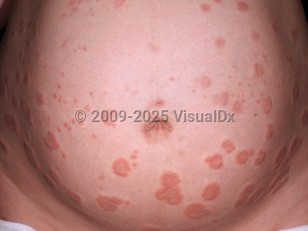Pemphigoid gestationis
Alerts and Notices
Important News & Links
Synopsis

Pemphigoid gestationis, also called herpes gestationis or gestational pemphigoid, is a rare, extremely pruritic vesiculobullous eruption that occurs during the third trimester of pregnancy or in the postpartum period. Patients typically present in the second or third trimester of pregnancy complaining of the abrupt onset of very pruritic urticarial papules and plaques, often within or adjacent to the umbilicus. This rapidly develops into generalized tense blisters, sparing the face, palms, soles, and mucous membranes.
Seventy-five percent of patients worsen dramatically at the time of delivery, and 25% present with de novo blisters in the postpartum period. Recurrence with future pregnancies is common, and disease may be more severe with each pregnancy; however, up to 5% of women will have no manifestation of the disease with the subsequent pregnancy. Recurrence with menstruation and with use of oral contraceptives is common.
Pemphigoid gestationis is characterized by autoantibodies against BP180 (BPAg2 or collagen XVII) and complement C3 deposition along the dermoepidermal junction on direct immunofluorescence. One theory of pathogenesis suggests that aberrant expression of paternal major histocompatibility complex class II antigens on the placenta initiates production of antibodies against placental basement membrane zone antigens, which then cross-react with skin. Virtually all patients with HG have anti-HLA antibodies, and nearly 50% have the HLA DR3 and DR4 haplotypes.
Pemphigoid gestationis is rare, occurring in 1 in 50 000 pregnancies. Since it is associated with HLA types DR3 and DR4, its occurrence in different populations is dependent on the frequency of those alleles.
Although there is no increase in birthing parent mortality, a 2009 study of 61 pregnancies complicated by pemphigoid gestationis found that onset in the first or second trimester and presence of blisters may lead to adverse pregnancy outcomes, including decreased gestational age at delivery and low-birth-weight children. Such pregnancies should be considered high-risk. Whether this results in increased infant mortality has been a matter of debate, but the most recent studies indicate that infants born to birthing patients with pemphigoid gestationis do not have increased rates of death. Systemic corticosteroid treatment does not substantially affect pregnancy outcomes.
Up to 10% of newborns will have bullous lesions secondary to placental transfer of antibodies.
Cases of similarly presenting disease have been reported in men with choriocarcinoma and women with hydatidiform mole, trophoblastic tumors, and choriocarcinoma.
Seventy-five percent of patients worsen dramatically at the time of delivery, and 25% present with de novo blisters in the postpartum period. Recurrence with future pregnancies is common, and disease may be more severe with each pregnancy; however, up to 5% of women will have no manifestation of the disease with the subsequent pregnancy. Recurrence with menstruation and with use of oral contraceptives is common.
Pemphigoid gestationis is characterized by autoantibodies against BP180 (BPAg2 or collagen XVII) and complement C3 deposition along the dermoepidermal junction on direct immunofluorescence. One theory of pathogenesis suggests that aberrant expression of paternal major histocompatibility complex class II antigens on the placenta initiates production of antibodies against placental basement membrane zone antigens, which then cross-react with skin. Virtually all patients with HG have anti-HLA antibodies, and nearly 50% have the HLA DR3 and DR4 haplotypes.
Pemphigoid gestationis is rare, occurring in 1 in 50 000 pregnancies. Since it is associated with HLA types DR3 and DR4, its occurrence in different populations is dependent on the frequency of those alleles.
Although there is no increase in birthing parent mortality, a 2009 study of 61 pregnancies complicated by pemphigoid gestationis found that onset in the first or second trimester and presence of blisters may lead to adverse pregnancy outcomes, including decreased gestational age at delivery and low-birth-weight children. Such pregnancies should be considered high-risk. Whether this results in increased infant mortality has been a matter of debate, but the most recent studies indicate that infants born to birthing patients with pemphigoid gestationis do not have increased rates of death. Systemic corticosteroid treatment does not substantially affect pregnancy outcomes.
Up to 10% of newborns will have bullous lesions secondary to placental transfer of antibodies.
Cases of similarly presenting disease have been reported in men with choriocarcinoma and women with hydatidiform mole, trophoblastic tumors, and choriocarcinoma.
Codes
ICD10CM:
O26.40 – Herpes gestationis, unspecified trimester
SNOMEDCT:
86081009 – Herpes gestationis
O26.40 – Herpes gestationis, unspecified trimester
SNOMEDCT:
86081009 – Herpes gestationis
Look For
Subscription Required
Diagnostic Pearls
Subscription Required
Differential Diagnosis & Pitfalls

To perform a comparison, select diagnoses from the classic differential
Subscription Required
Best Tests
Subscription Required
Management Pearls
Subscription Required
Therapy
Subscription Required
References
Subscription Required
Last Reviewed:03/30/2020
Last Updated:05/12/2025
Last Updated:05/12/2025
Pemphigoid gestationis

